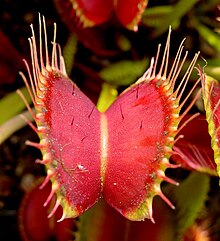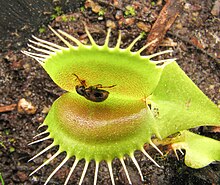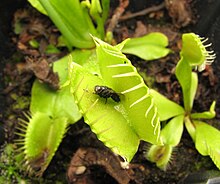Dionaea muscipula
Dionaea muscipula is the only species of the monotypic genus Dionaea, a carnivorous plant of the Droseraceae family. The common name dionea flytrap or venus flytrap refers to its feeding habit of catching live prey, mainly insects and arachnids. It is native to the southeastern United States.
Description
Dionaea muscipula is a small plant whose structure is formed by a rosette of four to eight leaves that arise from a short bulbous underground stem. Each stem reaches a maximum height of between 3.5 to 10 cm; depending on the time of year. Longer leaves with stout traps are normally formed after flowering. Plants with more than seven leaves are colonies formed by rosettes that have divided underground by the rhizome.
The leaf blade is divided into two regions: a flat, heart-shaped petiole capable of photosynthesis, and a pair of lobes hinged on the midrib that constitute the true leaf and form its respective trap. The upper face of these lobules contains red anthocyanin pigments and their edges secrete mucilage. The lobes show rapid vegetative movement, snapping shut when stimulated by prey. The capture mechanism is activated when the prey makes contact with two of the three hair-like trichomes found on the upper part of each of the lobes. This mechanism is so specialized that it can distinguish between living prey and various stimuli such as drops of water; in the case of a prey, it must touch two of the hairs in a twenty-second interval or just one twice in rapid sequence., after which the lobes close within a tenth of a second. The edges are scalloped by intertwining hair-like protrusions that prevent prey from escaping. These protrusions and the trigger hairs, or sensitive hairs, are probably homologous to the tentacles of its close relative Drosera. Although scientists do not know the exact evolutionary history of the Venus flytrap, some hypotheses suggest that it could have evolved from Drosera.
The gaps between the cilia allow small prey to escape, because the benefit to them would be less than the cost of digesting them. In this case, the trap will open in twelve hours, but if the prey does not escape and continues to move inside the trap, it closes completely, starting the digestion process. In the event that the prey moves more often, the digestion process is accelerated.
Closing speed can vary, depending on the amount of moisture, light, size of prey, and general growing conditions. The speed at which the trap closes can be used as an indicator of a plant's overall health. D. muscipula is not dependent on moisture, as are some other carnivorous plants, such as Nepenthes, Cephalotus, most Heliamphora and some species of Drosera.
This species shows variations in the shape and length of the petiole and whether the leaf lies flat on the ground or stands upright at an angle of about forty to sixty degrees. The four main forms are: 'typica', the most common, with broad decumbent petioles; 'erect', with leaves at a forty-five degree angle; 'linearis', with narrow petioles and leaves at forty-five degrees and 'filiformis', with extremely narrow or linear petioles. Except 'filiformis', the other three can be phases of leaf production of any plant, depending on the season (decumbent in summer vs. short vs. semi-erect in spring), the length of the photoperiod (long petioles in spring versus short in summer) and light intensity (wide petioles with little light versus narrow ones with more).[citation needed]
When grown from seed, the plant takes four to five years to reach maturity and lives twenty to thirty years if grown under the right conditions.
Capture mechanism
D. muscipula is a member of a small group of plants capable of rapid movement, such as Mimosa pudica, the traffic light plant (Desmodium motorium), Drosera and Utricularia.
The mechanism by which the trap snaps shut involves a complex interplay between elasticity, turgor, and growth. In the open and deactivated state, the lobes are convex (bent out), but in the closed state they are concave (forming a cavity). It is the rapid flip of this bistable state that closes the trap, however the mechanism that triggers this process is still not fully understood. When the sensory hairs are stimulated, an action potential (mainly involving calcium ions) is generated, which propagates through the lobes and stimulates both their cells and those of the central vein. Exactly what this stimulation does is still debated. The acid growth theory asserts that individual cells in the outer layers of the lobules and central vein rapidly move 1H+ (hydrogen ions) into the cell walls, lowering the pH and releasing extracellular components, which allow them to rapidly dilate by osmosis. thus elongating and changing the shape of the lobes. Alternatively, it is possible that cells in the inner layers of lobules and central vein secrete other ions, allowing water to flow by osmosis and the cells to collapse. Possibly both mechanisms play their role and there is some evidence that supports it.
Digestion
If the prey is unable to escape it continues to stimulate the inner side of the lobes, causing a further dilation response that presses the edges against each other, eventually sealing the trap tightly, forming a " stomach" in which digestion occurs. This digestion is catalyzed by enzymes secreted by the glands in the lobules.
Oxidative protein modification is a likely predigestive mechanism. Quinones such as naphthoquinone plumbagin have been found in aqueous foliar extracts to combine with different NADH-dependent diaphorases to produce superoxide and hydrogen peroxide by autoxidation. Such oxidative modifications could disrupt the animal's cell membranes. Plumbagin is known to induce apoptosis, associated with regulation of the Bcl-2 family of proteins. When Dionaea extracts were preincubated with diaphorases and NADH in the presence of serum albumin (SA), it facilitated the subsequent tryptic digestion of SA. Since the exocrine glands of Droseraceae contain peptidases and, possibly, other degenerative enzymes, it may be that the presence of redox-activated oxygen cofactors function as predigestive oxidants to make the proteins of the membranous walls of the prey more susceptible to proteolytic attack.
Digestion takes around 10 days, after which the prey has been reduced to a chitinous shell. Then the trap is reopened ready to hunt again.
Distribution and habitat
Dionaea muscipula grows in nitrogen-poor environments, such as swamps and wetlands, where the soil is composed of sandstone or peat. Due to its small size, it depends on periodic burning to suppress its competitors, but although it tolerates fire well, this system threatens its future in the wild.
Although it is cultivated successfully in many parts of the world, its native habitat is only the states of North Carolina and South Carolina, in the southeastern United States, specifically within a radius of about 100 km around Wilmington (North Carolina). One such location is Green Swamp. There is also a naturalized population in northern Florida as well as some in the Pine Barrens, New Jersey. The nutrient poverty of the soil is the reason why this species employs such elaborate traps: insects supply the nitrogen for protein formation that the soil cannot. This carnivorous plant is not a tropical plant, so it requires a relatively mild climate, with not too cold winters. In fact, if it does not go through a period of dormancy in winter, it weakens and dies after a certain time.
Cultivars
Dionaea is by far the most cultivated carnivorous plant. It is usually sold as an indoor plant in florists, nurseries and supermarkets. During the last ten years, a large number of cultivars created from genetic mutations of selected tissues grown in the laboratory have appeared on the market.
Among the registered cultivars, the following can be highlighted:
- Dionaea muscipula 'Akai Ryu'
- Dionaea muscipula 'Alien'
- Dionaea muscipula 'All Green'
- Dionaea muscipula 'B52'
- Dionaea muscipula 'Big Mouth'
- Dionaea muscipula 'Bimbo'
- Dionaea muscipula 'Bohemian Garnet'
- Dionaea muscipula 'Bristle Tooth'
- Dionaea muscipula 'Clayton's Red Sunset'
- Dionaea muscipula 'Crocodile'
- Dionaea muscipula 'Cupped Trap'
- Dionaea muscipula 'DC XL'
- Dionaea muscipula 'Dentate'
- Dionaea muscipula 'Fused Tooth'
- Dionaea muscipula 'Green Dragon'
- Dionaea muscipula 'Holland Red'
- Dionaea muscipula 'Jaws'
- Dionaea muscipula 'Korean Melody Shark'
- Dionaea muscipula 'Low Giant'
- Dionaea muscipula 'Microdent'
- Dionaea muscipula 'Mirror'
- Dionaea muscipula 'Phalanx'
- Dionaea muscipula 'Pink Venus'
- Dionaea muscipula 'Red Piranha'
- Dionaea muscipula 'Red Rosetted'
- Dionaea muscipula 'Royal Red'
- Dionaea muscipula 'Sawtooth'
- Dionaea muscipula 'Schuppenstiel I'
- Dionaea muscipula 'Wacky Traps'
- Dionaea muscipula 'Werewolf'
There is an unofficial list that includes many more names, increased annually. None of these "name variations" it is officially recognized unless the name is properly documented, registered and accepted by the International Registration Authority for cultivars of carnivorous plants, the International Carnivorous Plant Society.
Within which the following can be highlighted:
- Dionaea muscipula 'Dutch'
- Dionaea muscipula 'Dutch Delight'
- Dionaea muscipula 'Funnel Trap'
- Dionaea muscipula 'Kim Jong Un'
- Dionaea muscipula 'Red Dentate'
- Dionaea muscipula 'Red From' or 'All Red'
- Dionaea muscipula 'Spider'
- Dionaea muscipula 'Titan'
Cultivation
Venus flytraps are popular, however they have a reputation for being difficult to grow. The success of its cultivation depends on how faithfully it can reproduce its natural habitat. It requires a substrate free of mineral salts, a good mixture is quartz sand and 50% sphagnum peat. Irrigation should be done with acidic and not basic water, from rain (free of sediments) or distilled, since the dissolved salts of running water could kill it. A pH of 5 or 6 is optimal. The use of fertilizers is highly harmful (all the nutrients it needs are obtained from its prey). It needs an exposure to full sun, since without enough light it weakens and dies. Since its natural habitat is swamps where the soil is constantly flooded, the plant's substrate must always be humid and it is convenient to place a tray with a little water under the pot (preferably plastic, which better preserves humidity), If you choose to keep it in a glass container, for example, it is vital that it always have a finger of liquid at the bottom, which of course will be free of lime and mineral salts.
The appropriate temperature would be between 18 and 26 °C in summer and during the day. Sudden changes favor him. Therefore at night it would be positive if it dropped drastically. In winter it supports between 5 and 10 °C or less, but it does not tolerate frost.
During the inactive time (dormant) the watering should be much less and the plant should be allowed to rest in a cold place (it can be outside if there is no risk of frost) and sunny. This stage should coincide with winter. However, plants purchased in nurseries or shopping centers are usually manipulated, when they grow the first year it is possible that they do not have a dormant period.
In its habitat, Dionaea produces, in spring, floral stems of about 30 cm, which are born from the center of the rosette with five or six small flowers at the apex. In cultivation, many growers remove this flowering stem as soon as it is 5-6cm, as flowering consumes too much energy and reduces spade and trap (leaf) growth. If it is allowed to flower, it is advisable to pollinate it, for this a little pollen is collected (with a toothpick, for example) and rubbed against the stigma. This can be done with the same flower or with another from the same plant, it is what is called self-pollination. Some twenty to thirty seeds will be obtained as black balls of 1 mm in diameter that after three or four weeks of stratification in a humid and cold environment can be sown in peat.
Taxonomy
Dionaea muscipula was described by John Ellis and published in The St James's Chronicle; or the British Evening Post no. 1172: [p. 4] 1768.
- Sinonimia
- Dionaea corymbosa (Raf.) Steud. (1840)
- Dionaea crinita Sol. (1990) Nom. superfl.
- Dionaea dentata D'Amato (1998) Nom. nud.
- Dionaea heterodoxa D'Amato (1998) Nom.nud.
- Dionaea muscicapa A.St.-Hil. (1824) sphalm.typogr.
- Dionaea sensitiva Salisb. (1796)
- Dionaea sessiliflora ▪(auct. non G.Don: Raf.) Steud. (1840)
- Dionaea uniflora (auct. non Willd.: Raf.) Steud. (1840)
- Drosera corymbosa Raf. (1833)
- Drosera sessiliflora auct. non G.Don: Raf. (1833)
- Drosera uniflora auct. non Willd.: Raf. (1833)
Contenido relacionado
Uracil
Cycas revoluta
Odo of Good







